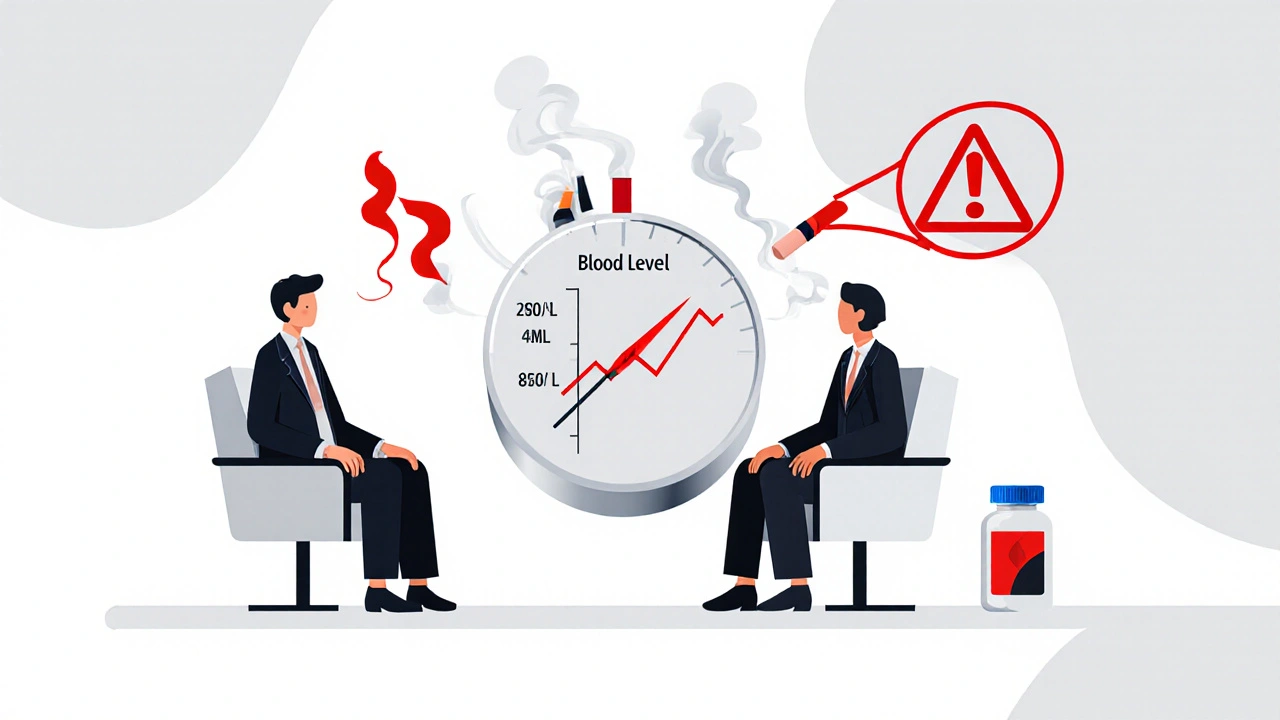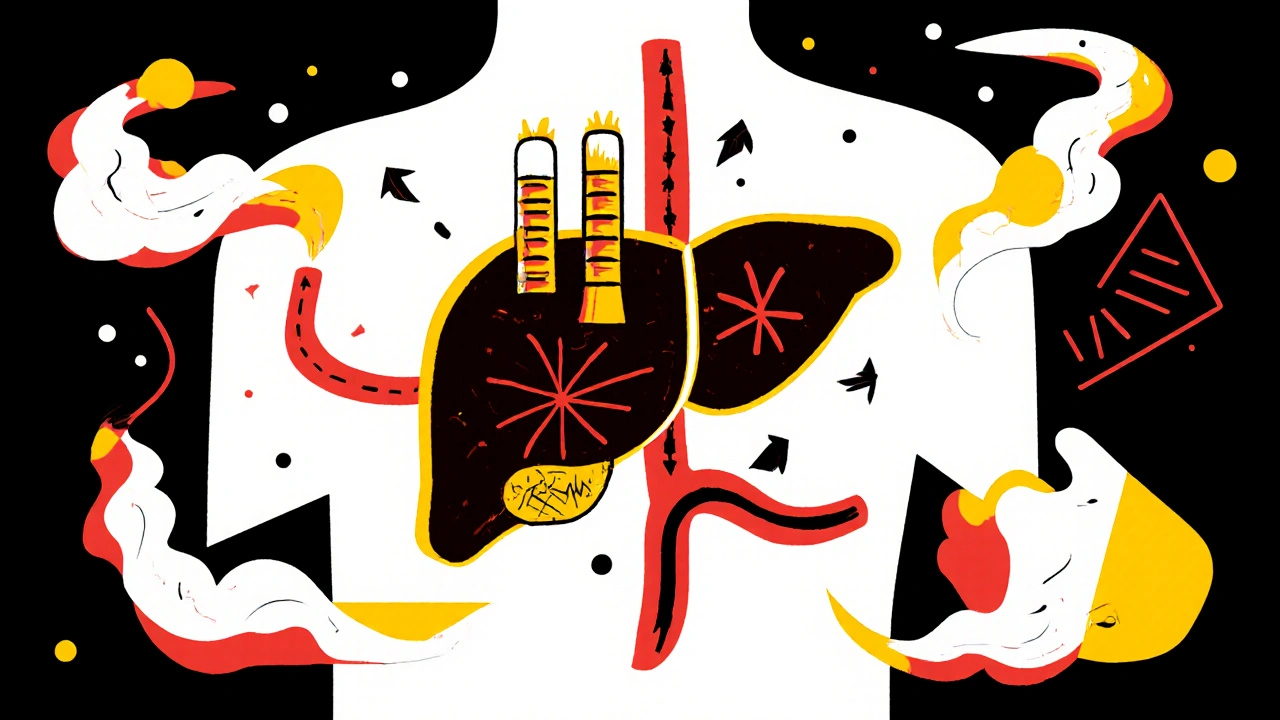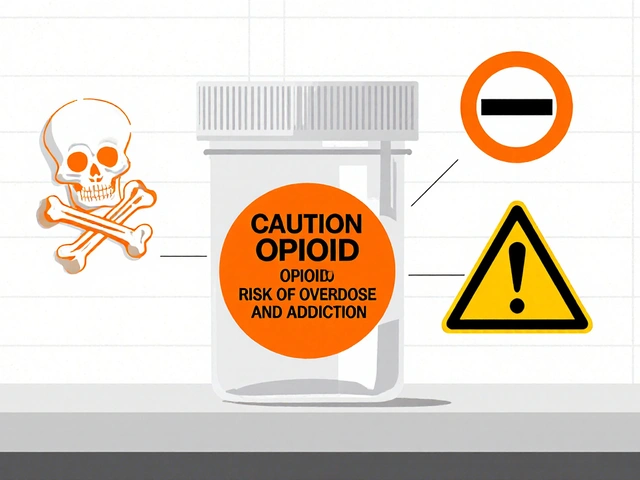Clozapine Dose Adjustment Calculator
Clozapine Dose Calculator
Recommended Adjustment
- Therapeutic range: 350-500 ng/mL
- Toxic level: >900 ng/mL
- Smokers often need 40-60% higher doses
- Quitters need dose reduction by 30-50%
- Always adjust under medical supervision
If you’re taking clozapine and you smoke, your medication might not be working like it should. It’s not because you’re doing anything wrong - it’s because tobacco smoke changes how your body processes the drug. This isn’t a minor side effect. It’s one of the most powerful and dangerous drug-environment interactions in psychiatry. People who smoke while on clozapine often need clozapine doses that are 40% to 60% higher than non-smokers just to stay in the therapeutic range. And if they quit smoking without telling their doctor? They can end up in the hospital - or worse.
Why Smoking Lowers Clozapine Levels
Clozapine is broken down in your liver by an enzyme called CYP1A2. This enzyme is like a factory worker that chops up the drug so your body can get rid of it. Tobacco smoke doesn’t just irritate your lungs - it tells your liver to build more of this enzyme. The chemicals in cigarette smoke, especially polycyclic aromatic hydrocarbons, activate something called the aryl hydrocarbon receptor. This switch flips on the CYP1A2 gene, making your liver produce way more of the enzyme.That means clozapine gets processed faster. Instead of staying in your bloodstream long enough to control your symptoms, it’s cleared out too quickly. Studies show that on average, smoking reduces clozapine levels by 30%. But for heavy smokers, the drop can be as high as 50%. That’s not a small fluctuation - it’s the difference between symptom control and a full relapse.
It doesn’t take long for this to happen. Within 48 to 72 hours of starting to smoke regularly, CYP1A2 activity ramps up. And it doesn’t disappear right away when you quit. The enzyme sticks around for 1 to 2 weeks. That’s why people who stop smoking often feel worse - not because their illness is returning, but because their clozapine dose is now too high.
How This Compares to Other Antipsychotics
Not all antipsychotics react this way. Olanzapine is also metabolized by CYP1A2, but clozapine is uniquely vulnerable. Why? Because clozapine has a narrow therapeutic window - the difference between the right dose and a toxic one is small. The safe and effective range is 350 to 500 ng/mL. If your level drops below 300, symptoms often return. If it climbs above 900, you risk seizures, heart problems, or even death.Other drugs like risperidone or aripiprazole are broken down by different enzymes (CYP2D6), so smoking doesn’t touch them. Quetiapine? Mostly handled by CYP3A4. So if you’re switching medications because of smoking, those are safer options - but they’re not always as effective for treatment-resistant schizophrenia. Clozapine still works better than anything else for about 30% of patients who haven’t responded to other drugs. That’s why doctors keep prescribing it, even with this complicated interaction.
Genetics Make It Even More Complicated
Your genes play a big role too. Some people have a CYP1A2 gene variant called *1F/*1F. On its own, it doesn’t change how fast they metabolize clozapine. But when they smoke? Their enzyme activity spikes way more than in people without this variant. That means two smokers on the same dose can have totally different blood levels - one might be fine, the other might be in danger.That’s why some clinics now test for CYP1A2 genetics before starting clozapine. It’s not routine everywhere yet, but it’s becoming more common. If you know you have this variant, your doctor can start you on a higher dose if you smoke, or be extra careful if you plan to quit.

Real-Life Cases: What Happens When People Smoke or Quit
Here’s what this looks like in real patients:- A 32-year-old man with schizoaffective disorder was on 450 mg of clozapine daily. His blood level was 280 ng/mL - below the therapeutic range. He was still having hallucinations. Turns out he was smoking a pack a day. His dose was increased to 650 mg. Within a week, his level hit 420 ng/mL. His symptoms improved.
- A 45-year-old woman quit smoking cold turkey. She didn’t tell her doctor. She stayed on her 400 mg dose. Two weeks later, she was confused, dizzy, and her heart was racing. Her clozapine level? 850 ng/mL - toxic. She was hospitalized. Her dose was cut to 250 mg.
- One Reddit user said, “I tried to quit smoking three times. Each time, I ended up in the ER because my clozapine levels went toxic before my doctor noticed.”
These aren’t rare cases. Psychiatrists on professional networks report that 68% check smoking status at every visit for clozapine patients. Eighty-two percent adjust doses based on smoking changes. That’s because the risk is too high to ignore.
What Doctors Should Do
There’s a clear protocol for managing this:- Check clozapine blood levels before starting treatment - and again after any change in smoking habits.
- If a patient starts smoking, increase the dose by 40-60%. Recheck levels after one week.
- If a patient quits smoking, reduce the dose by 30-50%. Monitor closely for two weeks.
- Don’t assume vaping is safe. E-cigarettes also induce CYP1A2 - just slightly less than regular cigarettes.
Many hospitals now have electronic alerts built into their systems. If a patient on clozapine has a smoking status flagged in their chart, the system reminds the doctor to check levels. A 2023 study showed these alerts cut adverse events by 37%.

The Bigger Picture: Why This Matters
About 60-70% of people on clozapine smoke - compared to just 14% of the general U.S. population. That’s not a coincidence. People with serious mental illness smoke more, often as a way to cope. But this interaction makes their treatment harder, riskier, and more expensive.Unmanaged, this interaction leads to 22% higher hospitalization rates. Each avoidable hospital stay costs about $14,500. The National Institute of Mental Health has poured over $2 million into research just to fix this problem.
And it’s not just about money. It’s about quality of life. Patients who get this right can live stable, meaningful lives. Those who don’t? They cycle in and out of hospitals. Their symptoms never fully resolve. Their families are exhausted.
What Patients Should Do
If you’re on clozapine:- Be honest with your doctor about smoking - even if you think it’s not a big deal.
- Don’t stop smoking without telling your doctor. If you’re trying to quit, work with them to adjust your dose ahead of time.
- Ask if your clozapine level has been checked recently. If not, request it.
- If you’re using e-cigarettes or nicotine patches, tell your doctor. They still affect CYP1A2.
- Keep track of your symptoms. If you feel worse after starting to smoke - or worse after quitting - it might be your medication, not your illness.
There’s no shame in needing a higher dose because you smoke. This isn’t about willpower. It’s about biochemistry. And your doctor should be prepared to adjust your treatment - not judge you for it.
The Future: Better Tools on the Horizon
Researchers are working on solutions. A new sustained-release clozapine formulation is in clinical trials. Early results show it reduces blood level swings by 40% in smokers - meaning fewer dose adjustments and less risk.Genetic testing for CYP1A2 is becoming more accessible. In 2018, only 15% of U.S. academic centers used it. By 2023, that number jumped to 47%. The FDA now considers the clozapine-smoking interaction a model case for studying how environment, genes, and drugs interact.
But until these tools are everywhere, the basics still matter most: know your smoking status. Know your blood level. Adjust your dose. And never assume it’s “just a cigarette.”
Does vaping affect clozapine levels like smoking does?
Yes. E-cigarettes contain chemicals that also induce CYP1A2, though the effect is about 15-20% weaker than traditional cigarettes. If you switch from smoking to vaping, your clozapine levels may still drop - just not as much. You still need to tell your doctor and get your blood levels checked.
Can I quit smoking while on clozapine?
Yes - but not without medical supervision. Quitting smoking causes clozapine levels to rise quickly, which can lead to toxicity. Your doctor needs to reduce your dose by 30-50% before or right after you quit. Monitor for dizziness, confusion, fast heartbeat, or seizures. Don’t try to quit cold turkey without a plan.
How often should clozapine levels be checked?
Baseline levels should be checked before starting treatment. After any dose change - especially due to smoking status - levels should be rechecked within 4-7 days. If you’re stable and not changing your smoking habits, every 3-6 months is typical. But if you’re a smoker who’s trying to quit, check every 1-2 weeks during the transition.
What if I don’t smoke but my clozapine level is still low?
CYP1A2 can be induced by other things too. Certain medications like carbamazepine, oxcarbazepine, and phenytoin can boost enzyme activity. Charcoal-grilled meats and some dietary supplements may also play a role. If your level is low and you don’t smoke, ask your doctor to review all your medications and supplements.
Is there a way to test if my CYP1A2 enzyme is overactive?
Yes. Researchers have found that CYP1A2 activity in white blood cells (leukocytes) closely matches liver activity. Some specialized labs offer tests that measure this. It’s not routine yet, but if you’re having trouble with clozapine dosing and no clear reason why, ask your psychiatrist about CYP1A2 phenotyping.
What happens if I ignore this interaction?
Ignoring it can be life-threatening. If you smoke and your dose is too low, your symptoms will return - you might relapse, get hospitalized, or lose your job or housing. If you quit smoking and don’t lower your dose, you risk clozapine toxicity: seizures, heart rhythm problems, myocarditis, or even agranulocytosis (a dangerous drop in white blood cells). The FDA requires monitoring for agranulocytosis anyway - but this interaction makes it even more urgent.







Kihya Beitz
November 16, 2025 AT 10:34So let me get this straight - if I smoke, I need more poison in my system to feel normal, and if I quit, I might die from the same poison? Thanks, medicine. 🙃
Jennifer Walton
November 16, 2025 AT 12:15The body is a machine. Smoke is a signal. The liver listens. Clozapine doesn’t stand a chance.
Adam Dille
November 17, 2025 AT 23:44This is wild but makes total sense 😮 I had no idea vaping counted too. My cousin’s on clozapine and just switched to vapes - guess she’s gotta get her levels checked. Thanks for the heads-up!
Katie Baker
November 17, 2025 AT 23:59I’m so glad someone’s talking about this. My brother’s been on clozapine for 8 years and smokes like a chimney. He’s stable now, but I’ve seen him crash when he tried to quit cold turkey. Doctors need to be way more upfront about this. You’re not weak for needing a higher dose - your liver’s just extra motivated 😅
John Foster
November 18, 2025 AT 00:31It’s not just about pharmacokinetics. It’s about the existential paradox of self-medication in a society that pathologizes coping. The cigarette becomes a sacrament - a ritualized act of biochemical rebellion against a system that offers no relief except more chemicals. We don’t treat the trauma, we treat the symptom, then punish the symptom for altering the treatment. The real tragedy isn’t the enzyme induction - it’s that we’ve built a mental health system that demands patients become chemists just to survive.
Edward Ward
November 18, 2025 AT 17:52I’ve been on clozapine for 11 years - non-smoker - and my levels are always on the low end of therapeutic, even though I’ve never smoked. My doctor assumed I was non-compliant. Turns out, I eat a lot of charred meat (grilled steak weekly) and take St. John’s Wort for low mood. Turns out, both induce CYP1A2. So I wasn’t ‘non-compliant’ - I was biochemically sabotaged by my diet and my attempt to be holistic. I had to stop the supplement, reduce my grilled meat intake, and my levels stabilized. Point is: smoking isn’t the only culprit. If your levels are off, ask about everything - meds, supplements, even your BBQ habits. It’s not just about cigarettes. It’s about your whole environment.
Andrew Eppich
November 18, 2025 AT 21:49People should not smoke. Period. This is not a medical issue. It’s a personal responsibility issue. If you choose to poison yourself, don’t blame the drug for not working. Quit smoking. End of story.
Jessica Chambers
November 20, 2025 AT 20:16Andrew, you’re cute when you pretend this is about willpower. 😏 My sister’s been on clozapine since she was 19. She smokes because the voices won’t shut up and nothing else helps. You think she wants to be a ‘poisoned’ patient? She just wants to feel human. Maybe fix the system before you judge the person.